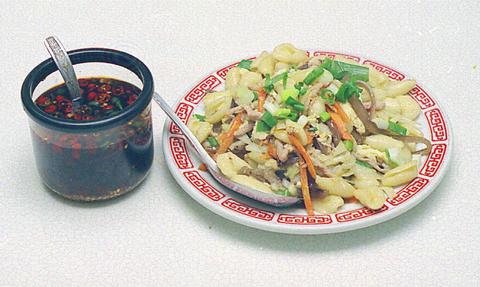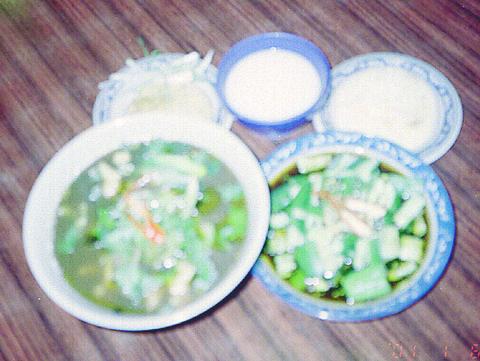Sha'anxi Paomo Restaurant (陝西泡饃館)
30, Lane 151, Chienkuo South Rd., Sec. 2 (北市建國南路二段151巷30號), Tel:2708-5552, 2705-6275. Open: 11am to 2:30pm, 5pm to 9:30pm; Average meal: NT$300; No English menu; Diners Club card only.
As the name suggests, this restaurant specializes in paomo -- and takes its obligations to its Muslim origins so seriously that, unusually for a restaurant in Taipei, it does not serve any pork. Meat dishes are restricted to beef and lamb.

PHOTO: YU SEN-LUN
Like Shau Shau Ke, the Sha'anxi Paomo Restaurant can be seen as a by-product of China's tourism development. Twelve years ago, owner Chou Hsiao-ping (周曉平), then a travel agent and a tour guide in northwest China, decided to learn how to cook the local food from a Muslim chef. A few years later, he gave up his travel business to open the Sha'anxi Paomo Restaurant.
The broth used for the paomo is probably the best of the three restaurants reviewed. It is made using only beef or lamb bones, which are stewed for over 20 hours. According to Chou, the word "mo" (饃) -- the unleavened dough used as the staple of this dish -- is derived from the Arabic word "turml." The eating of turml was introduced into western China in the 7th century from central Asia.
Many dishes can accompany a bowl of paomo. Chou recommends the pickled sugar garlic cloves (糖蒜), which add a sharp tang to the meal. It is also a good way of cleaning the mouth of the greasy feeling left after a heavy meat meal. Another specialty of the house is grilled leg of lamb (香酥羊腿), which is a must for any meat lover. The meat is very tender and fragrant, and is totally free of the smell that people associate with mutton. A special spice brought in from western China adds to the taste.

PHOTO: YU SEN-LUN
Sha'anxi Restaurant (陝西館)
166, Nanking E Rd., Sec. 3 (北市南京東路三段166號), Tel:2741-1285. Open: 11am to 3pm, 5pm to 8pm; Average meal:NT$150; No English menu; Credit cards not accepted.
You can probably get the best value paomo at this unpretentious little establishment. One of Taipei's oldest Sha'anxi restaurants, it is dwarfed by the glamorous Westin Hotel opposite. It has been around for 23 years, satisfying the nostalgic hunger of old mainlanders.

PHOTO: YU SEN-LUN
Originally, an old veteran from Sha'anxi ran the restaurant. When he passed away, his landlord, Lee Ping-tung (李炳東), who had studied how to make Sha'anxi food, took over the establishment, and continues to offer the traditional homestyle Sha'anxi dishes.
Here, the paomo is served with the "mo" slightly cooked into the broth, so the broth is thicker and more like a porridge. "But the `mo' still retains its chewy texture because the dough is made in the tradtional way," Lee said.
Sha'anxi Restaurant is also famous for it knife-cut noodles (刀削麵) and other dishes based on these noodles, including soups and fried noodle dishes. Cut noodles are widely available in Taipei, but a variation of this dish, called mao-er-duo (貓耳朵, "cat's ears"), is rarely found. Although it is based on the same dough as the cut noodles, the different presentation makes it quite a unique dish.
Mao-er-duo is chewy and is served fried, with mushroom, egg, radish and pork shreds. Its simplicity only seems to make it that much more delicious. Other dishes which are highly recommended are the noodles with pork and cabbage (
Shao Shao Ke (勺勺客)
15, Lane 41, Jenai Rd., Sec. 2(北市仁愛路二段41巷15號), Tel:2351-7148. Open: 11:30am to 2:30pm, 5:30pm to 10:30pm (closed Mondays); Average Meal: NT$500. No English menu. Credit cards accepted.
A Taiwanese girl visits China to study Chinese medicine and comes back a chef. This is the story behind one of Taipei's best-known Sha'anxi restaurants. Carly Lee (李櫻瑛) now offers the great tastes and the decor she experienced in the remote northwest of China.
Shao Shao Ke serves dishes from China's arid northwest, where unleavened bread, lamb and fragrant spices make up the cuisine of the area's predominantly Muslim population. "Sour and peppery flavors predominate here. And as for meat dishes, these are mostly crisp on outside and tender on the inside," said manager and owner Lee Fang-ling (李芳玲).
Chih-tzu Ribs (炙子骨排) is a justly popular dish that meets these criteria perfectly. The ribs are first stewed in Chinese medicine for many hours before being deep-fried to create an unforgettable mixture of taste and texture.
A typical peasant dish which is brought to a high level of culinary excellence at Shao Shao Ke is paomo (泡饃), a filling soup which uses a hard bread instead of noodles. A disc of the bread is first brought to you and you must break it into small pieces yourself. Only after you have done this will the rich meat broth be added.
Although green vegetables are scarce in the deserts of northwestern China, vegetable dishes are not unknown, and sour and spicy potato shreds (酸嗆土豆絲), a household staple in the region, makes for a fascinating variation on the usual Chinese dishes.
But Shao Shao Ke offers more than up-market versions of local peasant food. In line with a trend to promote dishes from China's past, the restaurant has worked up a number of "historical" dishes which are no longer found in regular Chinese cuisine. The ribs mentioned above is one such dish -- others feature fish, chicken and tofu, which are definitely not part of the modern-day Sha'anxi kitchen.

One of the biggest sore spots in Taiwan’s historical friendship with the US came in 1979 when US president Jimmy Carter broke off formal diplomatic relations with Taiwan’s Republic of China (ROC) government so that the US could establish relations with the People’s Republic of China (PRC). Taiwan’s derecognition came purely at China’s insistence, and the US took the deal. Retired American diplomat John Tkacik, who for almost decade surrounding that schism, from 1974 to 1982, worked in embassies in Taipei and Beijing and at the Taiwan Desk in Washington DC, recently argued in the Taipei Times that “President Carter’s derecognition

This year will go down in the history books. Taiwan faces enormous turmoil and uncertainty in the coming months. Which political parties are in a good position to handle big changes? All of the main parties are beset with challenges. Taking stock, this column examined the Taiwan People’s Party (TPP) (“Huang Kuo-chang’s choking the life out of the TPP,” May 28, page 12), the Democratic Progressive Party (DPP) (“Challenges amid choppy waters for the DPP,” June 14, page 12) and the Chinese Nationalist Party (KMT) (“KMT struggles to seize opportunities as ‘interesting times’ loom,” June 20, page 11). Times like these can

Dr. Y. Tony Yang, Associate Dean of Health Policy and Population Science at George Washington University, argued last week in a piece for the Taipei Times about former president Ma Ying-jeou (馬英九) leading a student delegation to the People’s Republic of China (PRC) that, “The real question is not whether Ma’s visit helps or hurts Taiwan — it is why Taiwan lacks a sophisticated, multi-track approach to one of the most complex geopolitical relationships in the world” (“Ma’s Visit, DPP’s Blind Spot,” June 18, page 8). Yang contends that the Democratic Progressive Party (DPP) has a blind spot: “By treating any

You can tell a lot about a generation from the contents of their cool box: nowadays the barbecue ice bucket is likely to be filled with hard seltzers, non-alcoholic beers and fluorescent BuzzBallz — a particular favorite among Gen Z. Two decades ago, it was WKD, Bacardi Breezers and the odd Smirnoff Ice bobbing in a puddle of melted ice. And while nostalgia may have brought back some alcopops, the new wave of ready-to-drink (RTD) options look and taste noticeably different. It is not just the drinks that have changed, but drinking habits too, driven in part by more health-conscious consumers and